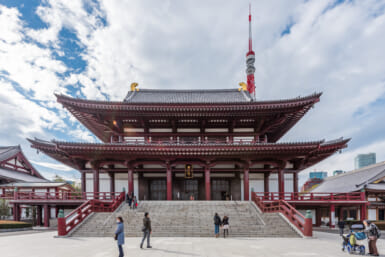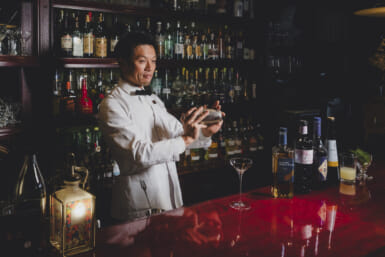by Kenneth Matthews
The solution to all this mean hijacking business is right here in Tokyo.
The notion came to me on the subway the other day, but I suppose it could have come anywhere. I was, not unusually, watching a young woman who happened to be riding in the same car. I mention this so that you will understand that I was not as alert to things around me as I might have been. I was off guard.
For it was at this moment that I doubled in pain. A sharp blow was smartly landed in my midsection. It was, of course, the work of a four-foot-tall, middle-aged lady with a shopping bag—three shopping bags—and a simulated leather handbag.
All middle-age Japanese women are obliged to carry three shopping bags and a simulated leather handbag. Furoshikis are optional equipment. More on that later.
As the pain began to subside and I was able to resume a more or less vertical position, I watched her as she continued toward the exit. When the train came to a halt in the station, she was, naturally, immediately in front of the door and the first to detrain. Several other of her victims were scattered about the subway car in various stages of agony.
The gentleman who always plants himself outside the opening doors, squeezing in as others are trying to get off finally met his match and I was glad of it in a perverse way. He caught a good left handbag uppercut somewhere below the belt I judged from his shrill scream. Justice was done. An ambulance was summoned to remove him.
You may have noticed I said that I was hit with a shopping bag but that the unfortunate door-blocker got his with a handbag. I should, therefore, like to digress with some advice to the newcomer.
Commuters’ rule No. 1. “It is better to take blows from a shopping bag than a handbag if one has a choice.”
It is possible that a shopping bag could contain something truly lethal like, say, a pineapple, but it is doubtful what with import quotas and tariffs being what they are. Shopping bags are much more likely to contain tofu, liquid edibles encased in vinyl bags, a change of clothes, rubber boots and the like, none of which are deadly.
Handbags are almost sure to immobilize you.
I cannot accurately say what these handbags contain. Once, after a sound wallop in a delicate place, I thought I heard a woman offer a giggle and a gomenasai. The idea came to me there on the floor that this apology must be one of those friendly gestures you always read about in letters to the editor in the Japan Times.
Now that you understand the full power of our potential anti-hijacking agents, let us examine how that might be deployed on the great international airliners instead of subterranean vehicles.
First we would have to supply the motivation. That is simple. Tell the recruits that it is (1) their duty to their country, (2) that it will enhance the prestige of Japan in the eyes of the world and (3) that it will benefit foreign trade.
A headquarters could be established in London or Paris where the several hundred Japanese matrons would be based. They would board all flights bound for possible trouble spots. Their only task would be to scamper up and down the aisles periodically during the flight armed to the teeth with shopping bags and handbags (furoshiki still being optional).
An unsuspecting hijacker, in the heat of his or her mission would, naturally, ignore these tiny ladies. He probably would never see them down there at. waist level. Then suddenly, one would strike. The hijacker is down for the count, docile and writhing. He is quickly and easily manacled by a stewardess, and the flight proceeds to its destination.
In time, fear and trembling would overwhelm the most ferocious guerrilla even thinking about a hijacking.
Oh, I know some cynics and the uninitiated will argue that small ladies with shopping bags are no match for Leila Khaled and dynamite, but they are wrong.
I promised a word or two on furoshikis. The furoshiki can be dangerous to the traveler because it can contain anything of almost any size. They are often enormous.
But furoshikis lack innocence. There is nothing clandestine about a furoshiki. To me they virtually scream, ‘WEAPON. BEWARE.” You see them coming and scurry out of the way.
Now, I will be the first to admit that there are some disadvantages to my plan. As you have already suspected, there is no way an airline could guarantee that law-abiding passengers might not be struck by accident. I cannot argue with this except to say that thechance is worth it. Medical attention would have to be readily available.
Secondly, it is not possible to assign just one or two women per plane. Traveling in such small numbers is contrary to the Japanese spirit. Twenty women is the absolute minimum number which could be assigned. But what is that in a 747, I ask?
There is a chance, too, that the ladies would refuse the filets mignon offered passengers at meal time, choosing instead to bring and cook their own ramen. This, as was demonstrated aboard a German train recently, would necessitate building a fire in the passenger compartment. But I should think that as long as the flames did not come too close to the oxygen storage area, this would be a minor inconvenience which other passengers would be pleased to endure. It is certainly better than spending a week or so parked in the steaming desert.
I think some caution must be exercised in the selection of the agents, however. I think they should be chosen only in Tokyo. Only the true Edoko has the years of training and experience required for such an important mission.
The other qualification is based on age. The agents cannot be too old. You may laugh derisively and say, “Ha, they’re never too old,” but my studies have shown that a woman of advanced years can be knocked off course by even a small man. Just the other day, I noticed a small creature of no more than eighty winters zooming in on a ticket window when she was sent careening by a chap hardly more than a midget himself. And she was fully armed. That kind of failure cannot be tolerated.








